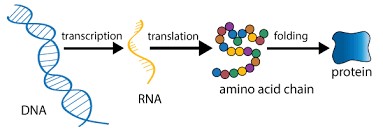Protein Expression
Proteins are the building blocks of all living organisms and play crucial roles in biological processes. To investigate how a particular protein modulates biological processes, many aspects of the protein such as structure, modification, localization, interaction, and function need to be studied. A considerable number of proteins, especially membrane proteins, are screened in drug discovery as biological targets or as potential drugs themselves. Most of these proteins are produced using cell-based or cell-free expression systems, which typically include the transcription of recombinant DNA into mRNA that is further translated into the protein under study.
Creative Biostructure uses both cell-based and cell-free systems to provide protein expression services to customers in the pharmaceutical industry, as well as research institutions.
 Figure 1. Protein expression begins
with DNA
Figure 1. Protein expression begins
with DNA
Traditional techniques for recombinant protein expression involve transfecting cells with a gene of interest and then culturing cells for transcription and translation of the target protein. This process uses living cells for protein expression and therefore is termed cell-based membrane protein expression. Both prokaryotic and eukaryotic protein expression systems are widely used. The bacterial system has the advantage of high yield, which is necessary for X-ray crystallography or NMR experiments for structure determination. However, bacteria are not equipped with the full machinery to finish the required post-translational modification or proper folding, which leads to insoluble or non-functional proteins. Thus, multiple eukaryotic cells, such as yeast, insect, plants, and mammalian cells, are developed to facilitate the expression of fully functional proteins.
In-vitro protein synthesis or cell-free protein synthesis (CFPS), are the approaches for protein production without living cells, but with cell extracts containing necessary molecular machinery. General cell extracts in use today are made from E. coli, wheat germ extracts, rabbit reticulocyte lysate, or insect cell lysate. With the addition of a template encoding the target protein, cell-free protein production can be accomplished.
 Figure 2. An example of cell-free protein
synthesis
Figure 2. An example of cell-free protein
synthesis
The membrane protein screening platform at Creative Biostructure has also developed other systems including virus-like particles (VLPs), liposome, Nanodisc, animal-free, and detergent-free systems to synthesize soluble and functional membrane proteins.
- Detergent-free Membrane Protein Expression
- Animal-free Membrane Protein Expression
- Nanodiscs Construction
Each system has its advantages and liabilities. The selection of the system depends on the type, required amount, and functional activities of the protein. The elite scientists at Creative Biostructure will choose the appropriate expression system to obtain high-quality membrane proteins to fulfill your specific research goals aiming at a high-resolution structural solution and innovative drug discovery. Please feel free to contact us for a detailed quote.
Please see the list of membrane proteins provided by Creative Biostructure.
Ordering Process
References
- Ramachandran N, et al. Self-assembling protein microarrays. Science. 2004, 305(5680): 86-90.
- Carlson E D, et al. Cell-free protein synthesis: applications come of age. Biotechnology Advances. 2012, 30(5): 1185-1194.
